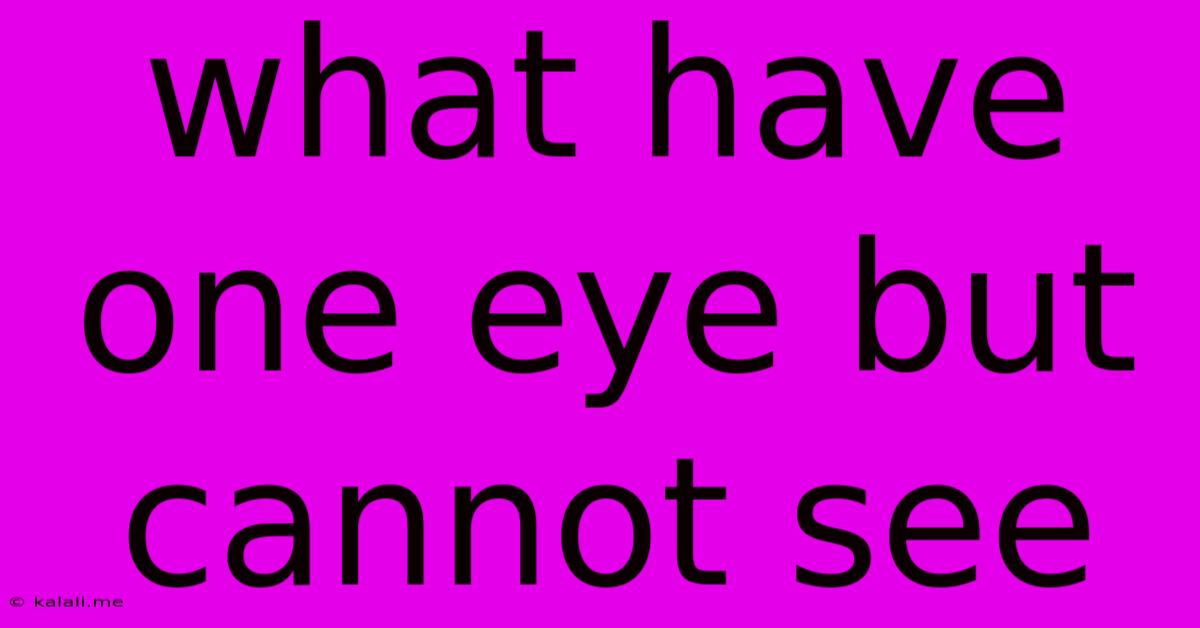What Have One Eye But Cannot See
Kalali
May 21, 2025 · 3 min read

Table of Contents
What Has One Eye But Cannot See? A Riddle and Exploration of Answers
This classic riddle, "What has one eye but cannot see?" has intrigued people for generations. The immediate answer that springs to mind is often a needle. This article will delve into why that's the most common answer, explore other possibilities, and even discuss how to approach similar riddles. This exploration will also cover the types of wordplay and lateral thinking often involved in solving these brain teasers.
The Most Common Answer: A Needle
The most accepted answer is indeed a needle. Needles possess a single hole at the eye of the needle, which is often referred to as its "eye." However, this eye clearly cannot see in the conventional sense. This answer perfectly encapsulates the clever wordplay at the heart of many riddles. The riddle plays on the double meaning of "eye," using a literal interpretation of a physical feature to deceive the solver into thinking of a visual organ.
Exploring Other Potential Answers (and Why They Might Not Be as Strong)
While the needle is the most satisfying answer, a few other possibilities could be considered, depending on the context and the creativity of the solver:
-
A cyclone: A cyclone, viewed from above, might appear to have a single "eye" at its center. However, this interpretation is far less common and relies on a much looser interpretation of the word "eye."
-
A potato (with a sprout): Some might argue a potato with a single sprout could be considered to have one eye, but this answer is even more tenuous than the cyclone example and heavily relies on visual metaphor.
Strategies for Solving Similar Riddles
Solving riddles like "What has one eye but cannot see?" often requires a combination of skills:
-
Identify the Wordplay: Look for words with multiple meanings or alternative interpretations. The key to many riddles lies in the clever use of language.
-
Think Outside the Box: Don't limit yourself to literal interpretations. Many riddles require lateral thinking and creative problem-solving.
-
Consider Context: Sometimes, the context of the riddle (e.g., its origin or the surrounding conversation) can provide clues.
-
Embrace Ambiguity: Some riddles are intentionally open to multiple interpretations, adding to their charm and complexity.
The Importance of Riddles in Language and Culture
Riddles have long held a significant place in human culture, serving as forms of entertainment, education, and even spiritual practice. They test our wit, encourage creative thinking, and often reveal the subtle complexities of language. This classic riddle about the needle is just a small example of how a simple question can stimulate our minds and lead us to explore hidden connections. The satisfying "aha!" moment when we solve a riddle is rewarding, demonstrating the power of language to both challenge and delight.
This article has explored the classic riddle "What has one eye but cannot see?", providing the most common answer and considering alternative possibilities. It emphasizes the importance of understanding wordplay and utilizing lateral thinking skills when approaching similar brain teasers. By understanding the mechanics of such riddles, you can become a more adept riddle-solver and appreciate the ingenuity of these linguistic puzzles.
Latest Posts
Latest Posts
-
How To Feed As Vampire In Skyrim
May 21, 2025
-
How Long Will A Flask Keep Water Hot
May 21, 2025
-
How To Have Sex In Islam
May 21, 2025
-
What Has 1 Eye But Cannot See
May 21, 2025
-
What Bible Do Eastern Orthodox Use
May 21, 2025
Related Post
Thank you for visiting our website which covers about What Have One Eye But Cannot See . We hope the information provided has been useful to you. Feel free to contact us if you have any questions or need further assistance. See you next time and don't miss to bookmark.